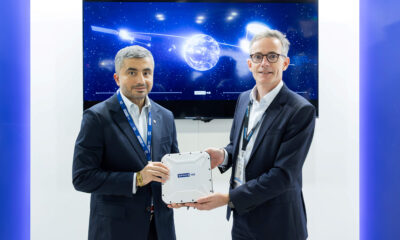News
5D Storage Technology Can Fit 500TB On A Small Disc
This method could theoretically be used to archive data for as long as 13.8 billion years.

While most consumers today are perfectly satisfied with the capacity and reliability of modern solid-state drives (SSDs), various organizations that are required to archive massive quantities of data are deeply aware of the limitations of not just SSDs but other currently available storage technologies as well.
Soon, they might be able to store up to 500TB of data on a CD-sized disc thanks to a new energy-efficient laser-writing method for producing high-density nanostructures in silica glass. Called five-dimensional (5D) optical data storage, this method could theoretically be used to archive data for as long as 13.8 billion years, and the optical discs produced by it can survive temperatures as high as 1,000 degrees Celsius.
“With the current system, we have the ability to preserve terabytes of data, which could be used, for example, to preserve information from a person’s DNA,” said Peter G. Kazansky, leader of the research team behind the new data storage technology.

5D optical data storage isn’t actually an entirely new invention, but its practical applications were greatly limited in the past because of its slow write speed. To improve it, the research team from the University of Southampton in the UK used a femtosecond laser to produce an optical phenomenon known as near-field enhancement, minimizing the thermal damage that prevented earlier researchers from making 5D optical data storage truly usable.
Also Read: Japan Sets A New Internet Speed Record With 319 Terabits Per Second
“This new approach improves the data writing speed to a practical level, so we can write tens of gigabytes of data in a reasonable time,” said doctoral researcher Yuhao Lei. By a reasonable time, Lei means about 100 pages of text (roughly 230 kilobytes of data) per second.
When you compare that figure to the writing speeds of modern SSDs (anywhere from 200 megabytes per second to 4,000 megabytes per second), it becomes apparent that regular consumers won’t be replacing their storage drives with it anytime soon.
News
Warner Bros. Discovery Invests In OSN Streaming To Expand MENA Reach
The move follows an exclusive deal between OSN and HBO in 2022 and its recent acquisition of a majority stake in music platform Anghami.

Warner Bros. Discovery (WBD) has acquired a stake in OSN Streaming Limited, a subsidiary of the OSN Group. The investment is part of WBD’s growing commitment to the Middle East and North Africa streaming market. The deal will be finalized in phases, pending regulatory approval.
For OSN, the partnership strengthens its leadership position in the region’s highly competitive streaming landscape. The company has been expanding its content portfolio through long-term partnerships, including an exclusive deal with HBO in 2022. Earlier this year, OSN also acquired a majority stake in music streaming platform Anghami, further diversifying its digital offerings.
Sheikha Dana Naser Sabah Al Ahmad Al Sabah, Group CEO of KIPCO and Chairperson of OSN, highlighted the importance of the partnership:
“We are delighted to be announcing this deal between WBD and OSN, which […] affirms the success of the strategy that KIPCO laid out to focus on and strengthen our streaming business, even in a competitive market environment. The transaction builds on OSN’s strong growth trajectory and market leadership in MENA’s streaming industry, strengthening its competitive position as one of the region’s premier entertainment destinations”.
Jamie Cooke, Executive Vice President & Managing Director for Central Europe, Turkey, and the Middle East at Warner Bros. Discovery, emphasized the importance of local content alongside global hits:
“It’s our goal to tell the greatest stories, whilst innovating our products and distribution channels […] We recognize that alongside enjoying the latest global hits, regional audiences also want stories from and about the region that reflect their own cultures and experiences. Through this deal, we’re delighted to announce that both OSN and Warner Bros. Discovery will invest in high-quality, locally produced content, ensuring a richer and more diverse offering for viewers”.
Also Read: Best Video Streaming Services In The Middle East
OSN Group CEO Joe Kawkabani echoed this sentiment, calling WBD’s investment a major milestone:
“We are thrilled to welcome WBD as a strategic partner. As a global leader in entertainment, WBD brings unparalleled expertise, innovation, and a rich portfolio of iconic brands. This investment is a significant milestone in OSN’s growth journey, reinforcing our dedication to delivering unique and compelling content. It also bolsters our commitment to expanding our investment in local content, broadening its reach beyond MENA to global audiences”.
WBD’s streaming services, Max and Discovery+, now boast nearly 117 million subscribers worldwide. The company’s increasing footprint in MENA is part of a broader expansion strategy that began with the opening of its Dubai office in 2012. Since then, WBD has steadily built its presence in the region, ensuring that MENA audiences have access to world-class entertainment.
-

 News3 weeks ago
News3 weeks agoExclusive: Honoring A Trailblazer In Advanced Technologies
-

 News2 weeks ago
News2 weeks agoSpace42 & Cobham Satcom Launch New Satellite Broadband Terminal
-

 News2 weeks ago
News2 weeks agoVernewell UK: Forging The Future Of Intelligence, Quantum, And AI
-

 News3 weeks ago
News3 weeks agoQuantum Innovation Summit Wraps Up 2025 Edition














